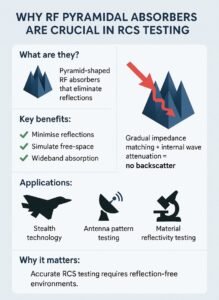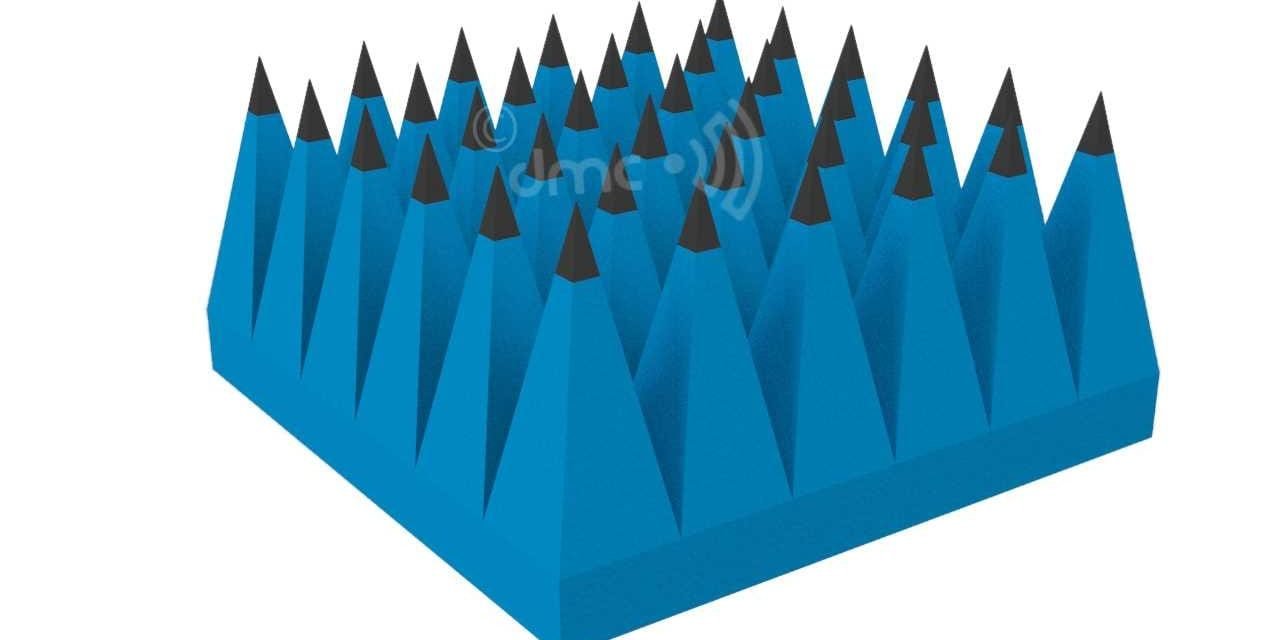In modern electromagnetic testing, accuracy is paramount. Whether for aerospace stealth technology, defence systems, or advanced antenna design, radar cross-section (RCS) testing plays a vital role. To achieve precise and reliable results, engineers depend heavily on creating an environment that mimics free space as closely as possible. Here, RF pyramidal absorbers become indispensable components in anechoic chambers. But what makes them so important in antenna RCS testing? Let’s understand in detail.
What are RF Pyramidal Absorbers?
RF pyramidal absorbers are specially engineered materials with a pyramid-shaped design, typically made from carbon-loaded foam or dielectric materials. Their structure is not merely aesthetic; the pyramid geometry ensures gradual impedance matching, allowing electromagnetic waves to enter and get absorbed effectively rather than being reflected into the chamber.
Why Are They Used in RCS Testing?
Radar cross-section testing aims to measure how detectable an object is to radar systems. Any stray reflection within the testing chamber can interfere with measurements, giving inaccurate results. RF pyramidal absorbers eliminate this problem by:
- Absorbing Incident Waves
When electromagnetic waves strike the absorber, they penetrate the foam and undergo multiple internal reflections within the pyramid structure. Each reflection leads to attenuation of the wave until it is converted into heat energy and dissipated, preventing any significant reflection back into the chamber.
- Simulating Free-Space Conditions
Accurate RCS testing requires a test environment similar to open-air free space, where there are no reflections from walls or surrounding structures. Pyramidal absorbers create these conditions inside the chamber, ensuring only the target’s radar signature is measured.
- Providing Broadband Performance
Antenna and RCS testing often involve multiple frequencies to analyze the target’s behavior across different radar bands. RF pyramidal absorbers are designed to work efficiently over a wide frequency range, typically from hundreds of MHz to tens of GHz, making them versatile for varied testing requirements.
- Improving Measurement Accuracy
By eliminating unwanted reflections, these absorbers reduce noise within the test environment. This enhances the signal-to-noise ratio (SNR), ensuring that data collected during tests is accurate, consistent, and reliable.

Why Are RF Pyramidal Absorbers Important in Antenna RCS Testing
Advantages Over Flat Absorbers
While flat absorbers provide some degree of absorption, they are generally less effective across broad frequency ranges, especially at lower frequencies. Pyramidal absorbers offer:
- Gradual impedance transition: The pointed geometry allows a smooth transition from air to absorber material, minimizing surface reflections.
- Effective low-frequency absorption: The pyramid height and structure enable absorption of long wavelengths that flat absorbers struggle to manage.
- Higher reflection loss: Pyramidal absorbers can achieve reflection losses greater than -40 dB across wide bands, ideal for RCS testing.
Applications in Antenna RCS Testing
Some key uses of RF pyramidal absorbers in RCS test environments include:
- Stealth Technology Analysis
Defence and aerospace industries use RCS testing to design stealth aircraft and naval vessels with reduced radar detectability. Pyramidal absorbers ensure the chamber does not interfere with these critical measurements.
- Material Reflectivity Testing
Engineers test the radar reflectivity of various coatings and materials used in stealth technology. Accurate assessment requires an absorber-lined environment to eliminate background noise.
- Target Signature Measurement
Whether testing missiles, drones, or antennas, knowing the true radar signature helps in design optimization and countermeasure planning.
- Antenna Pattern Testing
Antenna performance is evaluated in anechoic chambers lined with pyramidal absorbers to assess radiation patterns without reflections distorting results.
How Do They Work?
The fundamental working principle lies in their pyramid design and material composition. The pyramid tips create a gradual change in impedance, reducing reflection at the surface. As waves travel deeper into the pyramid, they encounter multiple reflections, each time losing more energy, until the wave is fully absorbed and converted into heat, thereby eliminating backscatter.
Selecting the Right Absorbers for RCS Testing
Key considerations while selecting RF pyramidal absorbers for RCS testing include:
- Frequency range of testing
- Required reflection loss
- Chamber size and absorber height
- Temperature and humidity resistance
Investing in high-quality absorbers ensures long-term performance stability and measurement reliability.
RF pyramidal absorbers are a critical component in accurate antenna RCS testing. Their ability to eliminate reflections, provide wideband absorption, and simulate free-space conditions ensures precise radar cross-section measurements critical for modern defence, aerospace, and communication systems. Without these absorbers, achieving accurate and reliable test data would be virtually impossible, making them an essential investment for any advanced RF test facility.

